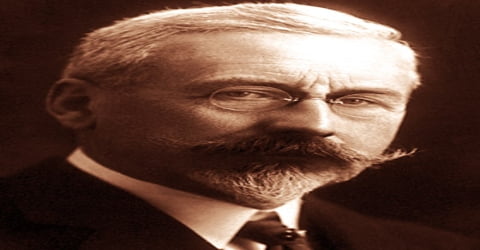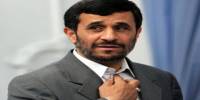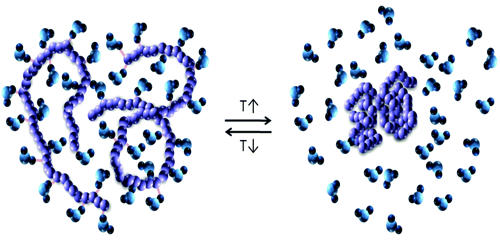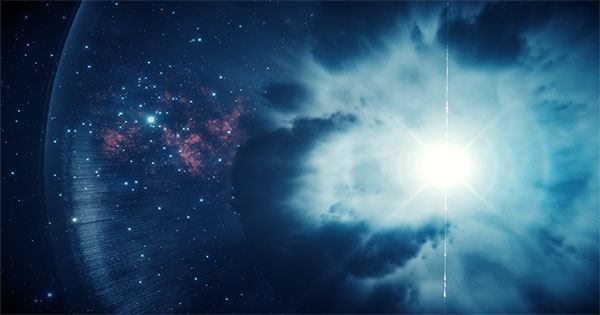Biography of John Logie Baird
John Logie Baird – Scottish engineer, an innovator.
Name: John Logie Baird FRSE
Date of Birth: 13 August 1888
Place of Birth: Helensburgh, Argyll and Bute, Scotland
Date of Death: 14 June 1946 (aged 57)
Place of Death: Bexhill, Sussex, England
Spouse/Ex-: Margaret Albu (m. 1931)
Father: Rev John Baird
Mother: Jessie Morrison Inglis
Children: Diana Baird and Malcolm Baird
Occupation: Inventor, businessman
Early Life
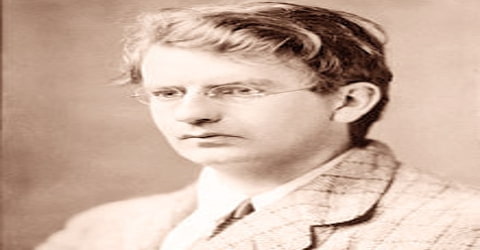
John Logie Baird was born Aug. 13, 1888, Helensburgh, Dunbarton, Scotland. He was a very famous Scottish engineer and inventor of one of the first televisions. He demonstrated his working television on 26 January 1926. He also demonstrated color television in 1928.
The fourth and youngest child of Rev. John and Jesse Baird, by his early teens he had developed a fascination with electronics and was already beginning to conduct experiments and build inventions. After completing his primary schooling, Baird studied electrical engineering at the Royal Technical College in Glasgow. However, his studies were interrupted with the outbreak of World War I, though he was rejected for service because of health issues. Left to pursue his interests in England, he worked for a utility company and started a manufacturing business before moving to Trinidad and Tobago where he briefly operated a jam factory. He became an agnostic, though this did not strain his relationship with his father. His degree course was interrupted by the First World War and he never returned to graduate.
In 1928 the Baird Television Development Company achieved the first transatlantic television transmission. Baird’s early technological successes and his role in the practical introduction of broadcast television for home entertainment have earned him a prominent place in television’s history.
The German post office gave him facilities to develop a television service in 1929. When the British Broadcasting Corporation (BBC) television service began in 1936, his system was in competition with one promoted by Marconi Electric and Musical Industries, and in February 1937 the BBC adopted the Marconi EMI system exclusively. Baird demonstrated color television in 1928 and was reported to have completed his researches on stereoscopic television in 1946.
Childhood, Family and Educational Life
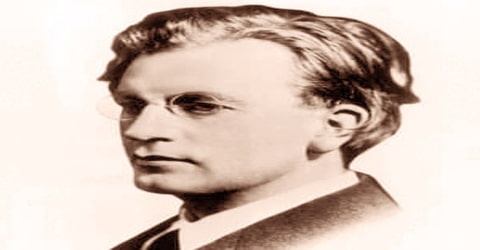
John Logie Baird was born on 14 August in 1888 in Helensburgh, Scotland. He was the youngest of four children of the Reverend John Baird and Jessie Morrison Inglis.
He was educated at Larchfield Academy (now part of Lomond School) in Helensburgh; the Glasgow and West of Scotland Technical College; and the University of Glasgow. While at college Baird undertook a series of engineering apprentice jobs as part of his course. The conditions in industrial Glasgow at the time helped form his socialist convictions but also contributed to his ill health. He became an agnostic, though this did not strain his relationship with his father. His degree course was interrupted by the First World War and he never returned to graduate.
At the beginning of 1915, he volunteered for service in the British Army but was classified as unfit for active duty. Unable to go to the Front, he took a job with the Clyde Valley Electrical Power Company, which was engaged in munitions work.
Personal Life
In 1931, the 43-year-old Baird married Margaret Albu. Together they had a daughter, Diana, and a son, Malcolm.
Career and Works
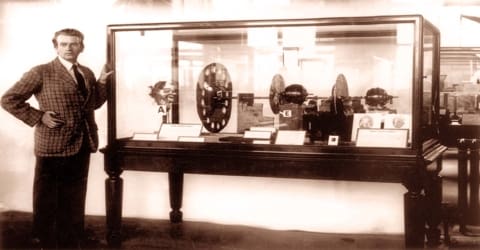
The development of television was the result of work by many inventors. Among them, Baird was a prominent pioneer and made major advances in the field. Many historians credit Baird with being the first to produce a live, moving, greyscale television image from reflected light. Baird achieved this, where other inventors had failed, by obtaining a better photoelectric cell and improving the signal conditioning from the photocell and the video amplifier.
His studies were disrupted due to the First World War, which he did not return to, however, he was not himself conscripted due to ill health.
Instead, Baird served as superintendent engineer of the Clyde Valley Electrical Power Company and later moved to Trinidad and Tobago where he briefly operated a jam factory.
Returning to the United Kingdom in 1920, Baird began to explore how to transmit moving images along with sounds. He lacked corporate sponsors, however, so he worked with whatever materials that he was able to scrounge. Cardboard, a bicycle lamp, glue, string, and wax were all part of his first “televisor.” In 1924, Baird transmitted a flickering image a few feet away. In July of the same year, he received a 1000-volt electric shock but survived with only a burnt hand, and as a result of his landlord, Mr. Tree asked him to vacate the premises. Baird gave the first public demonstration of moving silhouette images by television at Selfridges department store in London in a three-week series of demonstrations beginning on 25 March 1925.
When, in 1925, he succeeded in transmitting a televised image of a ventriloquist’s dummy, he said, “The image of the dummy’s head formed itself on the screen with what appeared to mean almost unbelievable clarity. I had got it! I could scarcely believe my eyes and felt myself shaking with excitement.”
On 26 January 1926, Baird repeated the transmission for members of the Royal Institution and a reporter from The Times in his laboratory at 22 Frith Street in the Soho district of London, where Bar Italia is now located. By this time, he had improved the scan rate to 12.5 pictures per second. It was the first demonstration of a television system that could broadcast live moving images with tone graduation.
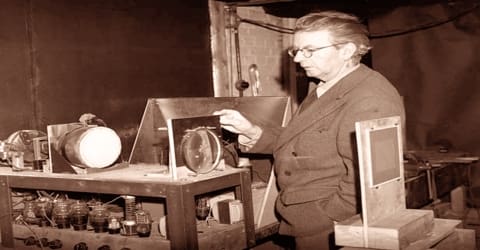
In 1927, Baird transmitted a long-distance television signal (sound and images) over 438 miles (705 km) of telephone line between London and Glasgow. He formed the Baird Television Development Company (BTDC) in 1928 and that same year he sent the first television transmission across the Atlantic Ocean from London to New York. Beginning in 1929, the BBC used Baird’s technology to broadcast its earliest television programming.
Baird’s technology, while the first form of television, had some intrinsic limitations. Because it was mechanical electronic television was being developed by others Baird’s visual images were fuzzy and flickering. In 1935, a BBC committee compared Baird’s technology with Marconi-EMI’s electronic television and deemed Baird’s product inferior. The BBC dropped it in 1937.
Baird televised the BBC’s first live outside broadcast with the transmission of The Derby in 1931. He demonstrated a theatre television system, with a screen two feet by five feet (60 cm by 150 cm), in 1930 at the London Coliseum, Berlin, Paris, and Stockholm. By 1939 he had improved his theatre projection to televise a boxing match on a screen 15 ft (4.6 m) by 12 ft (3.7 m).
In 1928, he developed an early video recording device, which he dubbed Phonovision. The system consisted of a large Nipkow disk attached by a mechanical linkage to a conventional 78-rpm record-cutting lathe. The result was a disc that could record and playback a 30-line video signal. Technical difficulties with the system prevented its further development, but some of the original phonodiscs have been preserved, and have since been restored by Donald McLean, a Scottish electrical engineer.
From 1929 to 1932, the BBC transmitters were used to broadcast television programmes using the 30-line Baird system, and from 1932 to 1935, the BBC also produced the programmes in their own studio at 16 Portland Place. On 3 November 1936, from Alexandra Palace located on the high ground of the north London ridge, the BBC began alternating Baird 240-line transmissions with EMI’s electronic scanning system, which had recently been improved to 405 lines after a merger with Marconi.
Baird made many contributions to the field of electronic television, demonstrating hybrid color in 1939 and “telechrome” in 1940. Baird continued his explorations for the rest of his life, developing electronic color television and 3-D television, though they were never reproduced beyond his laboratory.

In 1943, the Hankey Committee was appointed to oversee the resumption of television broadcasts after the war. Baird persuaded them to make plans to adopt his proposed 1000-line Telechrome electronic color system as the new post-war broadcast standard. The picture resolution on this system would have been comparable to today’s HDTV (High Definition Television). The Hankey Committee’s plan lost all momentum partly due to the challenges of postwar reconstruction. The monochrome 405-line standard remained in place until 1985 in some areas, and the 625-line system was introduced in 1964 and (PAL) color in 1967. A demonstration of large screen three-dimensional television by the BBC was reported in March 2008, over 60 years after Baird’s demonstration.
Awards and Honor

Australian television’s Logie Awards were named in honor of John Logie Baird’s contribution to the invention of the television. Baird became the only deceased subject of This Is Your Life when he was honored by Eamonn Andrews at the BBC Television Theatre in 1957.
In 2006, Baird was named as one of the 10 greatest Scottish scientists in history, having been listed in the National Library of Scotland’s ‘Scottish Science Hall of Fame’.
In 2015 he was inducted into the Scottish Engineering Hall of Fame.
On 26 January 2016, the search engine Google released a Google Doodle to mark the 90th anniversary of Logie Baird’s first public demonstration of live television.
Death and Legacy
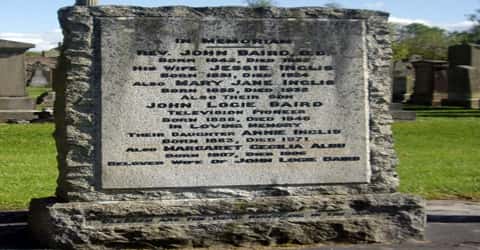
From December 1944, Logie Baird lived at 1 Station Road, Bexhill-on-Sea, East Sussex, immediately and north of the station. Baird suffered a stroke and died on June 14, 1946, in Bexhill-on-Sea in England. The house was demolished in 2007 and the site is now apartments named Baird Court. Logie Baird is buried with his mother, father, and wife in Helensburgh Cemetery, Argyll, Scotland.
Information Source:



